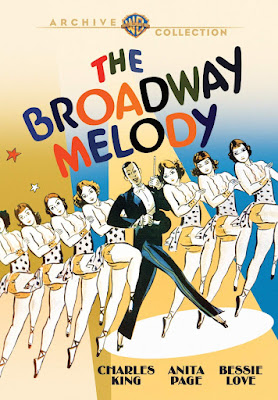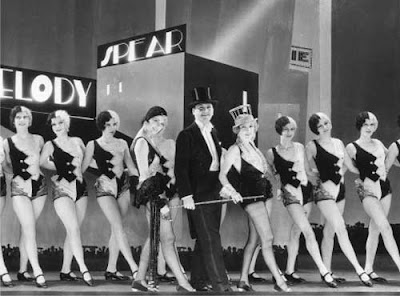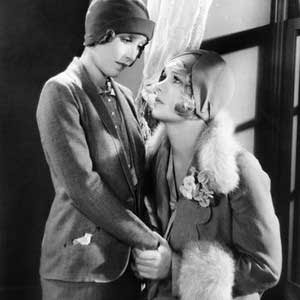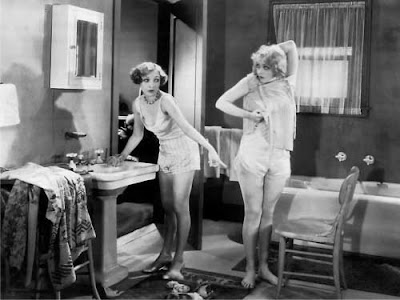
Director:
Harry Beaumont
Year: 1929
Rating: 6.5
Year: 1929
Rating: 6.5
I have been curious about the musicals from 1929 to see what they were like
and how musicals evolved in just a few short years to Busby Berkeley. It
was a big year for musicals and the audiences were eating them up. Talkies
were new but musicals had that added dimension that most of the public never
got to see - dancing, singing and big orchestral sound. Of the Top Ten Box
Office films that year, eight of them were musicals with this one leading
the pack. Not only that, it also won the Oscar for Best Film, the first sound
film to do so. It was a big MGM production from Irving Thalberg and was to
get MGM on track for their great history of musicals. Interestingly, a number
of these musicals had sections that were shot in color - as this one was
- but nearly all the color prints have been lost. Of course, it is
impossible to look at this film through the eyes of a 1929 audience that
was wowed by the film. I wish I could but now it feels a little creaky, the
acting somewhat stiff and the plot tired. But not back then.

This was the first musical to use the backstage story as the means to have songs. Many were to follow including some of those great Busby films. Musicals were not yet at the stage where a regular person on the street could break out in song. The musicals were either revues (which this one sort of turns into in a way) or set in situations where people might naturally sing. The camera was still not at ease with these set-ups and tended to stay back or have another set up for a quick close-up. So they are static and the dancing is generally limited to slow dances or chorus routines.

It isn't likely that people today know who any of the three leads are - all stars at the time but not for long. Anita Page had what was considered the most beautiful face on the screen - blonde with a bit of Monroe vulnerability. She retired in 1933 when she didn't get a raise and married the composer of the music for this film, Nacio Herb Brown. The other female lead is Bessie Love who was nominated for the Oscar as Best Actress - already a star at the time but this turned out to be the highpoint in her career. And the male lead Charles King was a top performer on Broadway - this was his debut in film - and after a couple more musicals he was to head back to Broadway. The only actor I was familiar with was one of my favorite character actors James Gleason in a small part - he was to be be in over 150 films - and was the writer of the dialogue here. Not sure if that would be something to brag about though.

The film begins with an overshot of New York City - a beautiful sight - and pans down to a Tin Pan Alley song office where King is trying out a new song he has written called The Broadway Melody. He is in a Broadway Revue and has that song in his pocket. His girlfriend (Love) and her younger sister (Page) have an act on vaudeville and are coming to town to try their hand on the Big White Way (do they still call it that?). King takes one look at little sis and it's who are you Bessie. And she has a look on her face a foot away from an orgasm. You know where this is headed. The scene when Bessie realizes that those two love each other, does the big sacrifice - "go get her you coward" and then cries her eyes out is still effective today.

There are six musical numbers. Broadway Melody became a hit and so did You Were Meant for Me. Brown wrote the music and the lyrics were written by Arthur Freed who was to go on to a tremendous career in musicals as the musical director at MGM and all those great films from the 1940s and 50s.


This was the first musical to use the backstage story as the means to have songs. Many were to follow including some of those great Busby films. Musicals were not yet at the stage where a regular person on the street could break out in song. The musicals were either revues (which this one sort of turns into in a way) or set in situations where people might naturally sing. The camera was still not at ease with these set-ups and tended to stay back or have another set up for a quick close-up. So they are static and the dancing is generally limited to slow dances or chorus routines.

It isn't likely that people today know who any of the three leads are - all stars at the time but not for long. Anita Page had what was considered the most beautiful face on the screen - blonde with a bit of Monroe vulnerability. She retired in 1933 when she didn't get a raise and married the composer of the music for this film, Nacio Herb Brown. The other female lead is Bessie Love who was nominated for the Oscar as Best Actress - already a star at the time but this turned out to be the highpoint in her career. And the male lead Charles King was a top performer on Broadway - this was his debut in film - and after a couple more musicals he was to head back to Broadway. The only actor I was familiar with was one of my favorite character actors James Gleason in a small part - he was to be be in over 150 films - and was the writer of the dialogue here. Not sure if that would be something to brag about though.

The film begins with an overshot of New York City - a beautiful sight - and pans down to a Tin Pan Alley song office where King is trying out a new song he has written called The Broadway Melody. He is in a Broadway Revue and has that song in his pocket. His girlfriend (Love) and her younger sister (Page) have an act on vaudeville and are coming to town to try their hand on the Big White Way (do they still call it that?). King takes one look at little sis and it's who are you Bessie. And she has a look on her face a foot away from an orgasm. You know where this is headed. The scene when Bessie realizes that those two love each other, does the big sacrifice - "go get her you coward" and then cries her eyes out is still effective today.

There are six musical numbers. Broadway Melody became a hit and so did You Were Meant for Me. Brown wrote the music and the lyrics were written by Arthur Freed who was to go on to a tremendous career in musicals as the musical director at MGM and all those great films from the 1940s and 50s.
